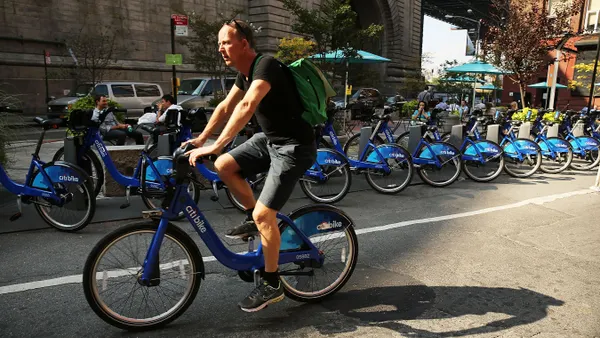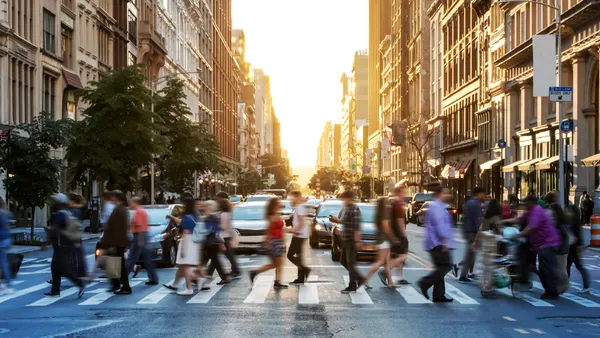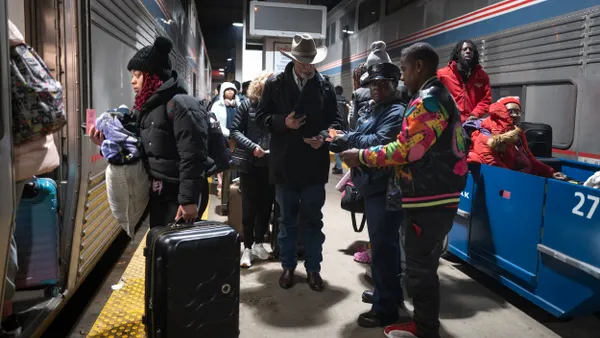Dive Brief:
- Oslo, Norway is getting closer to achieving a Vision Zero goal, with zero pedestrian or cyclist deaths last year. The city's lone traffic death occurred when a driver ran his car into a fence this summer — a decline from five traffic fatalities in 2018, according to Norwegian news outlet Aftenposten.
- Anders Hartmann, who works for Oslo's transportation and environment department, said in a tweet that while the city has made big strides, there is plenty of work still to be done, especially to make sure things get even better in the coming years.
- Advocates largely credit the reduction in fatalities to Oslo leaders laying out plans in 2015, and implementing them starting in 2017, to promote car-free urban life and boost street safety. The city removed more than 1,000 parking spaces, added more bike lanes and sidewalks, improved bike-share, launched public transit improvements and banned cars in some downtown areas.
Many people sharing this claim that we have reached #visionzero in Oslo. While we are making great progress, there is still a way to go to consistently keep deaths at zero for all road users.
— Anders Hartmann (@andershartmann) January 2, 2020
Also, #visionzero means 0 serious injuries, where we still have a long way to go.
Dive Insight:
Oslo's car-free city center approach is considered successful in improving citizens' lives on several fronts. It improves safety, reduces congestion — both for personal and public transit vehicles — and lessens vehicle emissions. That aligns with the city's ambitious climate goals of reducing carbon emissions 36% (compared with 1990 levels) by this year, 50% by 2022 and 95% by 2030.
Oslo has been regarded as a bike-friendly city for years, but its status has soared since it doubled down on car-free efforts a few years ago. Encouraging people to shift their habits involved a multi-pronged approach, and the safety improvements haven't solely occurred on the cycling side.
"It's increasingly difficult to bring a car into the city... What the city government decided to do is provide a lot more resources to build bicycle infrastructure all throughout the city," Trude Rauken, deputy director for the Carbon Neutral Cities Alliance (CNCA), told Smart Cities Dive. "To move people out of cars and to walking, biking and public transit, you need to make it attractive and safe."
Public transit has received plenty of attention as well. Oslo has taken a data-driven approach to boosting transit customer satisfaction and system use by increasing transit stop frequency, buying new equipment including electric buses and adopting contactless fare payments. The city also hopes to have up to 50 autonomous buses in service by next year.
Some safety advocates point out that to truly achieve Vision Zero means zero deaths for all road users, not just cyclists and pedestrians. It also means zero serious injuries, which Oslo still has to work on.
Norway as a whole has been making strides with street safety. The country announced a plan in 2016 to invest nearly $1 billion in intercity bike infrastructure to encourage cycling. And "bicycle hotels" are popping up in numerous cities. They're large, locked storage facilities near transit stations that can house hundreds of bikes at once. With features such as green roofs, the sites also serve as public spaces.
The Road Safety Annual Report 2019, recently released by the International Transport Forum, examines 41 countries' performance and repeatedly cites Norway's progress. The country nearly halved traffic deaths between 2010 and 2017, dropping from 208 to 107.
The country joined Greece in achieving the highest traffic death reductions during that time period. Those two countries also are the only ones in Europe projected to meet the United Nations' road safety target of a 50% road death reduction by 2020. "The success of Norway is particularly remarkable, as the country’s roads were already among the safest in the world," the report says.
City governments lead much of the charge for improving street safety and infrastructure, but they can learn and get assistance from partnerships with private companies, nonprofit organizations and other cities. Organizations like CNCA foster idea sharing among cities trying to solve similar challenges and reach like-minded environmental and safety goals.
"The support these cities get through peer exchange, training, working groups and projects we are providing them with is something they value greatly," Rauken said. "Transportation is always a topic our members are exchanging and collaborating on — getting people out of cars always is a theme at our meetings."
European cities generally are considered more advanced than U.S. cities on reducing personal vehicle use as a means to improve urban safety and address climate change concerns.
"We do know U.S. cities are more car-based cities," Rauken said. "In the end... it is not really a surprise considering the terms of the [federal] administration pulling the U.S. out of the Paris Agreement."
However, she points to progress in U.S. cities including New York, Portland, OR and Seattle that are advancing bicycle and electric vehicle infrastructure. These types of environmental and safety changes generally start at the local level, Rauken said, adding that it might take U.S. cities longer but they should experience dramatic progress over the next decade.
"It goes under the radar quite often what the cities are doing and how they are leading," she said. "It is all about the local efforts."










